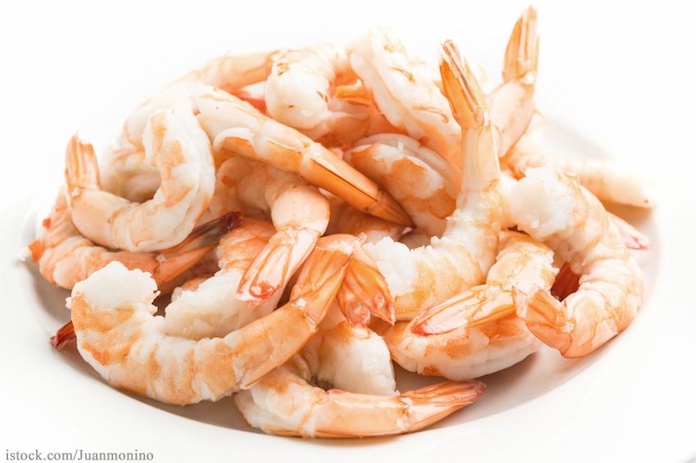Do you know where that shrimp in your freezer or on the plate in your favorite restaurant came from? And do you know what’s in it? Research in the last few years has found that antibiotic use in shrimp farming, especially in Asia, could pose a serious threat to public health.

A study in 2003 published in the International Journal of Food Science and Technology, titled “Antibiotic use in shrimp farming and implications for environmental impacts and human health” brought up the subject. It stated that antibiotics are used in shrimp farming to prevent or treat disease outbreaks, just as they are used on factory farms, but usage patterns were unknown.
That study was conducted along the coast of Thailand, which was the world’s largest producer of cultured shrimp until China took that title a few years ago (more about that later). At the time of the study, 20,000 shrimp farms were located along that country’s coastline. Scientists interviewed seventy-six farmers, and found that 74% of them used antibiotics, most prophylactically (to prevent disease) and on a daily basis. At least thirteen different antibiotics were used. And 86% of the farmers experienced problems with bacterial and viral diseases in their facilities.
This type of antibiotic use is well documented as one of the causes of antibiotic resistance in pathogenic bacteria. The Centers for Disease Control and Prevention (CDC) released a report in December 2016 through their National Antibiotic Monitoring Resistance System (NARMS) that stated that when animal are given low levels of antibiotics over a period of time, bacteria that naturally live in these animals develop resistance to the drugs.
About 700,000 people die every year from antibiotic-resistant infections. That number could increase to 10,000,000 a year by 2050 as we run out of antibiotics that can kill bacteria without killing us.
The FDA is well aware of this problem. They released Import Alert 16-131 on October 3, 2016 ordering detention without physical examination of aquacultured shrimp, dace, and eel from China, another country that farms shrimp and experts it to the U.S. In fact, 2016 was a record year for FDA refusals of shrimp that were deemed contaminated with banned antibiotics.
That alert states, “aquaculture seafood has been the fastest growing sector of the world food economy, accounting for approximately half of all seafood production worldwide. About 80% of the seafood consumed in the U.S. imported from approximately 62 countries.”
China is the largest producer of aquacultured seafood in the world. They produce 70% of the of the total production and 55% of the total value of aquacultured seafood exported around the world. And they use unapproved antibiotics and chemicals that pose a public health threat.
For instance, there is evidence that shrimp farmers in China use nitrofurans, malachite green, and gentian violet, which are carcinogenic. They also use fluoroquinolones, which are broad-spectrum antibiotics. Those chemicals are used to treat disease in, or affect the structure or function of seafood. The FDA has not approved those compounds in aquacultured animals.
In 2015, there were 404 refusals of shrimp entry lines for veterinary drug residues. After the Import Alert was issued in early 2016, there were 133 refusals of shrimp entry lines for drug residues. Most of the refused shrimp came from China, Vietnam, Malaysia, and India.
China is a particular problem in the fight against antibiotic resistance. Pigs were routinely given antibiotics of last resort, particularly colistin, in that country until the government changed their policy in November 2016. And most of the antibiotics fed to pigs pass undegraded into their waste.
A year earlier, scientists found a colistin-resistant gene in China that can be transmitted to other bacteria and turn them into “superbugs.” This affects shrimp farming, since waste from pig farms flows into coastline waters, where the shrimp farms are located.
Now there’s another problem, according to Bloomberg News: the distribution networks for seafood around the world are not transparent. That means we don’t know where the seafood that turns up in supermarkets and restaurants comes from. Companies create “disposable import companies” that close when regulators are aware of them.
Oceana, an organization that is dedicated to protecting the world’s oceans, published a report in October 2014 stating that, using DNA testing, they found that 30% of the 143 shrimp products tested from 111 grocery stores and restaurants around the country were misrepresented. That term means that farmed species were mislabeled as “Gulf shrimp,” that different species of shrimp were included in the same package, and that cheaper species were substituted for more expensive shrimp.
So what can you do about this? Consumer Reports has a guide to choosing the most responsibly sourced, healthiest shrimp that they published in 2015. They have a list of labels on any shrimp you buy that you should look for. They include the Marine Stewardship Council, Naturland, Aquaculture Stewardship Council, and Whole Foods Market Responsibly Farmed. Labels that mean nothing include “Environmental aware,” “Natural,” “No antibiotics,” “No hormones,” “Sustainable,” “Turtle Safe,” and “Organic.”




